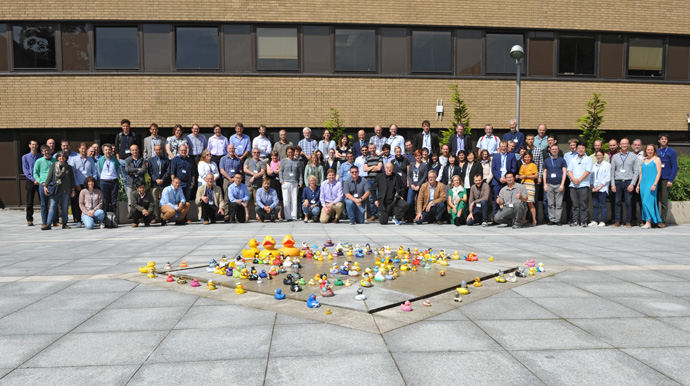ECMWF | Reading | 5-8 June 2018
A forum to discuss the use and performance of ECMWF's forecasts and related products
“Using ECMWF’s Forecasts” is open to all ECMWF forecast users. This year's theme provided an opportunity for participants to showcase innovative ideas, for example weather applications, forecast products or diagnostics tools. It also provided a framework where participants shared their experiences with ECMWF data and provided feedback on ECMWF products.
2018 theme: “ECMWF model output applications: the only limit is your imagination"
Weather is part of everybody’s life: we are curious about it, we want to plan our day or we use services (like energy, utilities) that are affected by it. Aviation, agriculture, energy, utilities, retail are some examples of sectors connected directly or indirectly to weather.
Weather data are transformed into relevant information to be used in decision making processes. Examples of this are indices alerting of favourable conditions for flu outbreaks and therefore helping people to make informed decisions regarding their health and well-being. Probabilities of winds being above or below specified thresholds provide means to effectively manage wind farms, and probabilities of occurrence of specified weather scenarios help farmers to minimise damages due to mildew on vineyards. These are just a few of the variety of applications that use weather information.
Let’s take a step further and imagine experiencing a severe weather event in virtual reality where you live. Could this experience help to make better decisions? Let us imagine using infographics to communicate forecast confidence. Would that make possible decision-making at a glance? This is what could be done with today’s ECMWF model outputs in addition to those applications in the water, energy, agriculture and health sectors that have already made use of ECMWF data.
UEF2018 focused on two thematic areas:
-
Processing of model outputs: a session dedicated to model output developments or visualisation with particular focus to innovative ideas that support forecasters when issuing weather warnings. Case studies demonstrating the use of new model output developments are welcomed.
-
Impact Forecasting: session looking at how weather forecasts are used in sectoral applications like water, energy, agriculture, fire and health. Applications aimed at mitigating the impact of severe weather, at forecasting health risks and at minimising adverse impacts of human activities on the environment (for example maximise the use of green energy, minimise the use of pesticides, effective use of medications to prevent allergic reactions) are examples of topics for this session.
Presentations
|
ECMWF product development |
|
|
ECMWF@UEF2018: past, present and future |
|
|
Verification news from ECMWF |
|
|
On the causes of systematic biases in near-surface weather parameters in the ECMWF forecasting system |
|
|
Forecasting the "Beast from the East" and Storm Emma |
|
|
Identification of weather factors affecting the number of refugees and migrants following the central Mediterranean route |
|
|
Perspective. Imagination. Key ingredients for happy users? |
|
|
Workshop: Simple access to quality weather data via API |
|
|
Using ECMWF data for impact based warnings |
|
|
Improvement of numerical model forecasts by using Meteodrone measurements in planetary boundary layer |
|
|
ECMWF forecasts for African small-scale farmers |
|
|
Imaginative insights or flights of (forecast) fantasy? |
not available |
|
Diagnostics of low frequency phenomena |
|
|
Calibration at ECMWF |
|
|
The relative contributions of ECMWF deterministic and ensemble forecasts in an automated consensus forecasting system |
|
|
Turbulence resolving weather forecasting: applications and operational aspects |
|
|
GloFAS/EFAS |
|
|
Fire danger: the skill provided by ECMWF ensemble prediction system |
|
|
Breaking the barriers: eLearning at ECMWF |
|
|
*ESoWC - ECMWF's Summer of Weather Code |
|
|
Exploring geoscience with AR/VR technologies |
|
|
Use of direct radiation forecasts to improve the reliability of solar thermal energy |
|
|
An ensemble-based storm surge forecasting system for the coast of Norway |
|
|
Project Loon and ECMWF |
not available |
|
The development of new products by forecasters - Example: Probability of Thunder algorithm |
|
|
Visualisation products using COSMO-LEPS: recent upgrades at Arpae-SIMC |
|
|
How climate information can be made user relevant and usable: the case of the Sectoral Information System of C3S |
|
|
Feedback Summary |
|
|
Feedback Plenary |
Posters
|
Sadibou Ba (Agence Nationale de l’Aviation Civile et de la Meteorologie, Senegal) |
|
|
Lucia Benito (Iberdrola Renovables) |
|
|
Leonore Boelee (HR Wallingford) |
|
|
Sandra Correia (IPMA) |
|
|
Sebastian Dietz (Universität Innsbruck) |
|
|
Yue Guan (National Meteorological Center / CMA) |
|
|
Tim Hewson (ECMWF) |
|
|
K.K. Hon (Hong Kong Observatory) |
|
|
Sazzad Hossain (Bangladesh Water Development Board) |
|
|
Patrick Laux (Karlsruhe Institute of Technology) |
|
|
Jeffrey Chi Wai Lee (Hong Kong Observatory) |
|
|
Alice Lemant (Météo-France) |
|
|
Sharanya Majumdar (Rosenstiel School of Marine and Atmospheric Science, University of Miami) |
|
|
András Mesterházy (OMSZ) |
|
|
Fatima Pillosu (ECMWF) |
|
|
Thomas Schumann (Deutscher Wetterdienst) |
|
|
Andrei Steau (NEAS Energy A/S) |
|
|
Vibeke Thyness (Met Norway) |
|
|
Roman Voisard (MeteoSwiss) |
|
|
W. K. Wong (Hong Kong Observatory) |
|
|
Jun Xu (National Meteorological Center / CMA) |

